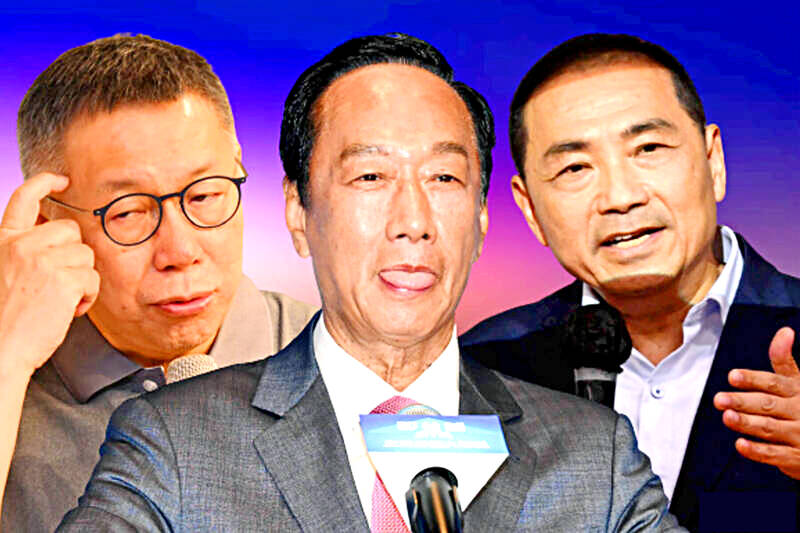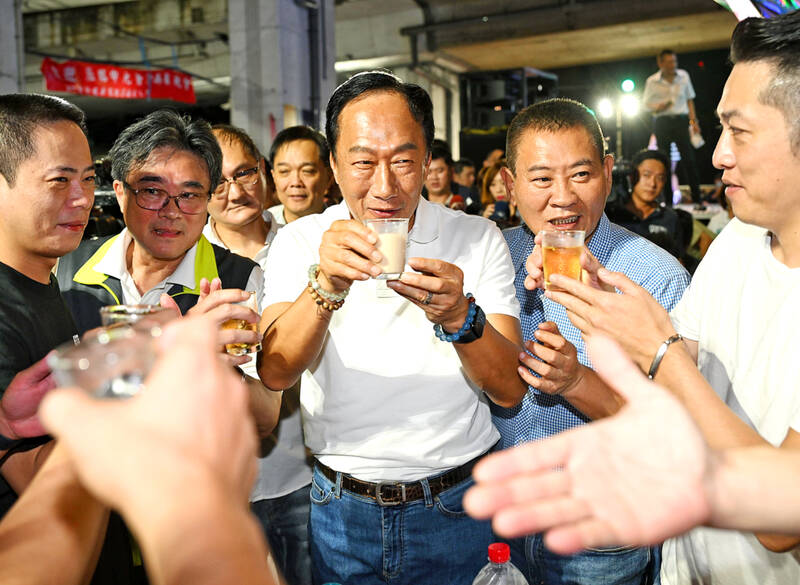Hon Hai Precision Industry Co (鴻海精密) founder Terry Gou (郭台銘) threw his hat in the presidential ring last week. Because he does not belong to a major party, he has to collect signatures from 1.5 percent of voters, or 290,000 people.
A million analyses are going to pour forth from the media, all which will amount to saying that Gou hurts the pro-China side by subdividing its minority vote even further, thus helping the pro-Taiwan side. Indeed, an interesting simulation of tactical voting in the election by longtime Japanese-Taiwan expert Ogasawara Yoshiyuki published by News Lens shows that Gou reduces Democratic Progressive Party (DPP) candidate William Lai’s (賴清德) threshold for winning to probably under 40 percent.
Gou will not merely divide the opposition more, but his constant nattering about China will also help the DPP by focusing attention on China policy, a DPP strength, instead of the DPP’s lackluster domestic performance.

Photo: Liberty Times
The more interesting question, posed by the very sharp scholar and commentator Sung Wen-ti (宋文笛),was why the Chinese Nationalist Party (KMT) keeps fracturing and tossing out multiple pan-blue candidates in every presidential election.
“It makes one wonder whether the ruling DPP enjoys a built-in advantage” he opined.
The answer to that is of course yes, it does. Things that happen repeatedly, like the multiplicity of people with KMT roots acting as candidates in elections, are structural problems.

Photo: Chang Chia-ming, Taipei Times
Indeed, Gou announced his run by alluding to this problem, saying that he was running to unite the opposition.
PRESIDENTIAL DEJA VU
A brief review of history. In the 1996 three KMT-linked candidates ran for president, against only one from the DPP. In addition to the far right more-KMT-than-the-KMT New Party, former Control Yuan president and longtime KMTer Chen Li-an (陳履安) ran as an independent and got nearly 10 percent of the vote. In 2000 there were five candidates, four of whom had KMT links, including former DPP chairman Hsu Hsin-liang (許信良), then aligned with the KMT, who received less than one percent of the vote.
In 2004 the pan-Blues were united, briefly, and came within a whisker of winning. In 2008 the KMT won convincingly, with no pan-blue rivals to cut into the party’s vote. In 2012 former KMTer James Soong (宋楚瑜) took less than 3 percent of the vote, but managed to reach nearly 13 percent in 2016. He would go on to take less than 5 percent in 2020. His party is not fielding a candidate in this election, but it, along with the New Party, still exists.
Indeed in the 2020 election the New Party nominated Yang Shih-kuang (楊世光), who complained that only women supported independence. His nomination was withdrawn in November of 2019 when he failed to gain enough signatures to appear on the ballot.
Yang’s failure shows how the stringent election rules that require that a candidate represent a major party or collect 1.5 percent of voters’ signatures help the KMT by cutting down on the number of ex-KMT politicians who can stand for president against it. This restriction helps foster the illusion that the blue camp is more united than it actually is. Gou has both the fame and funds to climb that fence.
As the political organization of a colonial elite, the KMT historically had two major functions in Taiwan: managing the links between the colonial one-party state and local politicians, and acting as the custodian of Mainlander identity. Note that neither of these conflicting functions involves winning elections.
Historically, the links between the KMT and local Taiwanese politicians are not mediated by some shared political identity, but by flows of money from the one-party government and party center. When those benefits cease or when local politicians feel slighted, local politicians will look for other options, easy for them since so many have independent local power bases.
This is a structural feature of KMT control, meaning that local elections often repeat the confusion at the top, with elections for county chief offering a melange of former KMT politicians turned independent running against each other and the KMT.
When this phenomenon occurred at the national level and Soong left the KMT in the 2000 election, he had spent the previous decade as Taiwan “provincial” governor and had visited nearly every township in the nation, cultivating local links.
MAINLANDER IDENTITY
The other issue is the KMT’s function as Church of the Mainlander identity. The purity struggles over the Mainlander identity invites politicians to spin off to its right whenever they feel the party has lost its theological way. Thus the New Party was originally born (as the Chinese New Party, which avowed it supported the ideals of Sun Yat-sen, 孫逸仙).
The flip side of Sung’s perspicacious question is why doesn’t the DPP do this? The answer is that while the KMT is an organization with a label on it saying WARNING: MAY CONTAIN PARTY-LIKE SUBSTANCE, the DPP is an actual political party, consciously founded as one, and unlike the KMT, without Leninist roots. It embraces a number of identities under the rubric of “Taiwaneseness.” Nor is the DPP the custodian of that identity, which is found in all Taiwan parties. Hence, no would-be independent politician can argue that they are more Taiwanese than the DPP, even to themselves.
There is nothing in the DPP remotely like the colonial relationship between the Mainlander elites at the KMT and the Taiwanese local politicians in the KMT. Nor is there a really strong rival pro-Taiwan party a DPP politician can find refuge in. A disgruntled DPPer is almost always better off waiting for a rival to move up or out, than leaving.
Gou may actually unite the opposition parties, but more by blunting their attempts to distinguish themselves from each other by burying them in rhetoric about China and peace than by bringing them together in any positive way.
Remember, that New Taipei City Mayor Hou You-yi (侯友宜) and Taiwan People’s Party Chairman Ko Wen-je (柯文哲), both candidates in next year’s presidential election, have to run to gain subsidies from the government for their parties. At present those subsidies are keeping the KMT alive, as longtime Taiwan politics observer Courtney Donovan Smith has pointed out in recent work, since many of its assets are frozen.
In the end, many are already privately observing, the election is unlike to feature three blue camp candidates. Somebody is going to make a deal, or drop out. And Gou has no party in need of subsidies under him.
Not that it matters. With the KMT, “all this has happened before, all this will happen again.”
Notes from Central Taiwan is a column written by long-term resident Michael Turton, who provides incisive commentary informed by three decades of living in and writing about his adoptive country. The views expressed here are his own.

Taiwanese chip-making giant Taiwan Semiconductor Manufacturing Co (TSMC) plans to invest a whopping US$100 billion in the US, after US President Donald Trump threatened to slap tariffs on overseas-made chips. TSMC is the world’s biggest maker of the critical technology that has become the lifeblood of the global economy. This week’s announcement takes the total amount TSMC has pledged to invest in the US to US$165 billion, which the company says is the “largest single foreign direct investment in US history.” It follows Trump’s accusations that Taiwan stole the US chip industry and his threats to impose tariffs of up to 100 percent

On a hillside overlooking Taichung are the remains of a village that never was. Half-formed houses abandoned by investors are slowly succumbing to the elements. Empty, save for the occasional explorer. Taiwan is full of these places. Factories, malls, hospitals, amusement parks, breweries, housing — all facing an unplanned but inevitable obsolescence. Urbex, short for urban exploration, is the practice of exploring and often photographing abandoned and derelict buildings. Many urban explorers choose not to disclose the locations of the sites, as a way of preserving the structures and preventing vandalism or looting. For artist and professor at NTNU and Taipei

March 10 to March 16 Although it failed to become popular, March of the Black Cats (烏貓進行曲) was the first Taiwanese record to have “pop song” printed on the label. Released in March 1929 under Eagle Records, a subsidiary of the Japanese-owned Columbia Records, the Hoklo (commonly known as Taiwanese) lyrics followed the traditional seven characters per verse of Taiwanese opera, but the instrumentation was Western, performed by Eagle’s in-house orchestra. The singer was entertainer Chiu-chan (秋蟾). In fact, a cover of a Xiamen folk song by Chiu-chan released around the same time, Plum Widow Missing Her Husband (雪梅思君), enjoyed more

Last week Elbridge Colby, US President Donald Trump’s nominee for under secretary of defense for policy, a key advisory position, said in his Senate confirmation hearing that Taiwan defense spending should be 10 percent of GDP “at least something in that ballpark, really focused on their defense.” He added: “So we need to properly incentivize them.” Much commentary focused on the 10 percent figure, and rightly so. Colby is not wrong in one respect — Taiwan does need to spend more. But the steady escalation in the proportion of GDP from 3 percent to 5 percent to 10 percent that advocates